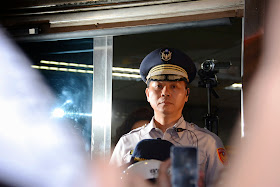A day after the
Sunflower Movement vacated the legislature, thousands of people we back outside
the building, this time to protest police action
Just a little
more than 24 hours after the Sunflower Movement evacuated the Legislative Yuan (LY)
following a 24-day occupation, about 2,000 people assembled in front of the
building on the night of April 11, this time to protest a police crackdown in
the morning and an announcement by police that a protest group that has
occupied the area for the past four years would no longer be allowed there.
The trigger was
the forceful removal of protesters from the Alliance of Referendum for Taiwan
outside the LY at 7am on April 11 after Zhongzheng First Police Precinct chief Fang
Yang-ning (方仰寧) had promised the group at 2:30am that
they would not be forced out. The Alliance, which has become a fixture outside
the legislature in the past four years, is led by Tsay Ting-kuei (蔡丁貴), a pro-independence activist and civil engineering teacher
at Syracuse University and NTU.
As police began
forcefully removing members of the Alliance and their supporters on the morning
of April 11, Tsay reportedly walked into incoming traffic on Zhongshan Rd. in
front of the legislature and was hit by a motorcycle. Accounts later claimed
that Tsay was nearly run over by a bus, but video footage of the incident shows
the vehicle approaching very slowly, suggesting that the driver had seen Tsay,
who by then was lying on the ground. Tsay was subsequently taken to hospital
for treatment. (This was not the first time for Tsay; I first met him in April
2010 as he was fighting a case involving an incident on Sept. 8, 2009, when he
collided with a car leaving the legislature.)
As they were
being evicted, police also announced that the Alliance’s permit to camp outside
the LY was no longer valid and that its presence would no longer be
countenanced. The move sparked a protest outside the Zhongzheng First Police
Precinct on Gongyuan Rd, where about 2,000 protesters gathered from 7pm,
calling for Police Chief Fang to step down. Fang appeared outside the precinct
accompanied by Taipei Mayor Hau Lung-bin (郝龍斌) and offered to resign if he’d done anything wrong. At
about 11pm, the crowd left the area and headed for the LY, where they launched
a sit-in in defiance of the police order. Although the legislature was heavily
guarded by police, the 2,000 or so protesters were left alone as activists made
speeches.
 |
| Protesters gather outside Zhongzheng First District |
A bit of
background is in order. Fang has been a regular figure for anyone who has
participated in, or observed, protests in the past 24 months. As the C.O. at
the scene, the police chief had earned a rather unenviable reputation as the
force behind the decision to force out, drag, and load onto buses protesters
who were agitating over the Cross-Strait Services Trade Agreement (CSSTA),
forced evictions and home demolitions (e.g., Dapu). Fang received a demerit
earlier this year — unfairly, in my opinion — for his “failure” to prevent the
crashing of a 35-tonne truck into the Presidential Office by a disgruntled
former Air Force officer. He was also the C.O. on Beiping Rd. behind the
Executive Yuan (EY) on the night of March 23-24 when riot police used excessive force against unarmed civilians.
His bad
reputation notwithstanding, Fang did a commendable job on April 1 when Bamboo
Union gangster Chang An-le (張安樂) and about 600 of his betel nut chewing
nutcases held a protest near the LY, preventing what could have been a
bloodbath had the protesters been able to come near the activists around and
inside the legislature. That night, I went over to him and thanked him for a
job well done — I even commended the work of the police officer who had pushed me and told me to get lost during a protest in front of the PO on July 18, the
day that four houses went down in Dapu.
Though reviled,
Fang isn’t the one who must go. His boss, National Police Administration
Director-General Wang Cho-chiun (王卓鈞), is the one who needs to step down. Wang’s alleged ties
with the Four Seas Gang, one of Taiwan’s main triads, are already grounds for
dismissal, not to mention the role that he played in the bloody crackdown at
the EY on March 23-24.
So as the
Sunflower Movement promised on April 10, the battle continues. Police behavior
and citizens’ right to assemble and protest — and the government’s denial of
such rights — is now part of the narrative of contention. (Photos by the
author)


No comments:
Post a Comment
Note: Only a member of this blog may post a comment.